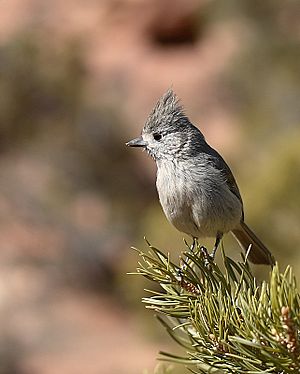Juniper titmouse facts for kids
Quick facts for kids Juniper titmouse |
|
|---|---|
 |
|
| Conservation status | |
| Scientific classification | |
| Genus: |
Baeolophus
|
| Species: |
ridgwayi
|
 |
|
| Range of Baeolophus ridgwayi | |
| Synonyms | |
|
Baeolophus griseus |
|
The juniper titmouse (Baeolophus ridgwayi) is a small, gray passerine bird. It belongs to the tit family, called Paridae. This bird was once thought to be the same as the oak titmouse.
However, in 1996, scientists realized they were different species. They found clear differences in their songs and where they live. Their genetic makeup also showed they were distinct.
Contents
About the Juniper Titmouse
The juniper titmouse is a small bird, mostly gray in color. It has a small tuft or crest of feathers on its head. Its face is plain, and its belly is a lighter shade of gray. Male and female birds look very much alike.
Where They Live
This titmouse lives all year long in certain areas. You can find it mainly in the Great Basin region. Its home stretches from southeastern Oregon and central Colorado. It goes south to the eastern Mojave Desert in California and central Arizona. You can also find it as far as west Texas and northeastern Sonora, Mexico.
The juniper titmouse loves open woodlands. It prefers warm, dry areas with pinyon and juniper trees. It also lives in desert areas near rivers.
Daily Life and Habits
Juniper titmice often sleep in tree holes or dense leaves. They might also use birdhouses. When sleeping in leaves, they pick a twig surrounded by thick foliage. This makes it feel like a safe, hidden spot.
These birds usually form pairs or small groups. They do not gather in large flocks. After the breeding season, they might join other bird species. They do this to find food together.
What They Eat
The juniper titmouse mainly eats insects and spiders. Sometimes, you can see them catching insects right out of the air. They also enjoy berries, acorns, and some seeds. They might hit seeds against branches to crack them open.
These birds look for food on leaves, twigs, and tree trunks. Sometimes, they even search on the ground. Their strong legs and feet let them hang upside down to find food. Juniper titmice also visit bird feeders. They like suet, peanut butter, and seeds.
Sounds and Calls
The song of the juniper titmouse is a series of rolling notes. All the notes are sung at the same pitch. Its call sounds like a rough tschick-adee.
Reproduction and Life Cycle
This species builds its nest inside tree holes. They might use holes made by woodpeckers or natural cavities. Sometimes, they use nest boxes. They line their nests with soft materials. These include grass, moss, mud, hair, feathers, and fur.
Juniper titmice breed from March to July. The busiest time is in April and May. They lay 3 to 9 eggs, but usually 4 to 7. The female bird mostly sits on the eggs to keep them warm. This takes about 14 to 16 days.
When the young birds hatch, they are helpless. Both parents take care of them in the nest for 16 to 21 days. After leaving the nest, the parents still look after them. This continues for another three to four weeks.
Juniper Titmouse vs. Other Titmice
The oak titmouse and juniper titmouse look almost the same. However, their voices are different, and they live in different places. The oak titmouse has a browner back than the juniper titmouse.
The oak titmouse sings a repeated series of three to seven syllables. Each syllable has one low and one high note. The juniper titmouse song is a series of fast syllables all on the same note. Their ranges only overlap in a small part of California.
The tufted titmouse lives in a different area. It has a whiter belly, rusty sides, and black on its forehead.
See also
 In Spanish: Herrerillo de Ridgway para niños
In Spanish: Herrerillo de Ridgway para niños


